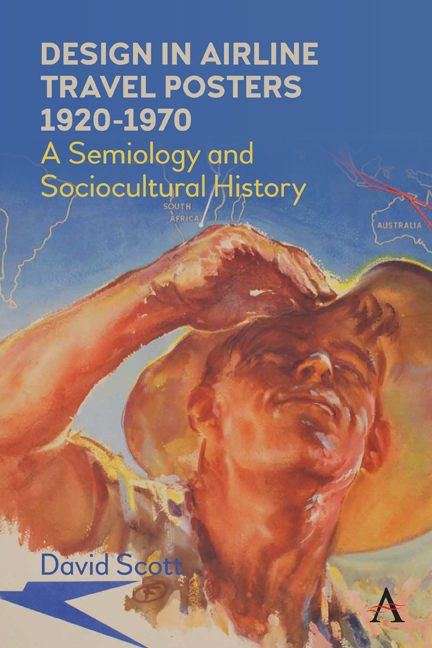Book contents
- Frontmatter
- Dedication
- Contents
- List of Figures
- Introduction
- 1 Fact and Fantasy: Reading and Misreading the Poster Image
- 2 People, Places and Planes: Destinations and Itineraries
- 3 Looking Out and Looking Up: Framing Devices and Indexical Signs
- 4 Indigenous Peoples
- 5 Glamour and Sex Appeal: Designing Desire
- Conclusion: The Decline of the Airline Travel Poster
- References
- Index
3 - Looking Out and Looking Up: Framing Devices and Indexical Signs
Published online by Cambridge University Press: 09 February 2021
- Frontmatter
- Dedication
- Contents
- List of Figures
- Introduction
- 1 Fact and Fantasy: Reading and Misreading the Poster Image
- 2 People, Places and Planes: Destinations and Itineraries
- 3 Looking Out and Looking Up: Framing Devices and Indexical Signs
- 4 Indigenous Peoples
- 5 Glamour and Sex Appeal: Designing Desire
- Conclusion: The Decline of the Airline Travel Poster
- References
- Index
Summary
A poster is not structured like a picture: having more in common with a postage stamp, it is an indexical as much as an iconic sign in that it points to a specific official or commercial message rather than merely presenting a mimetic image. This indexical dimension is manifested in the text that accompanies it, even if it is as minimal as a logo or the name of an airline. This fact is often overlooked by viewers who have become so used to the poster format that they are no longer conscious of the double nature of its structure as a sign. So, the poster by its very nature combines an alluring visual image or icon, with a textual clue – what Roland Barthes (1964) described as ancrage or anchorage for the image's meaning. The art of the poster lies in the combination of the iconic (visual) and indexical (textual) message, a synthesis that is enhanced if the symbolic elements that constitute the indexical message (the letters or language used) are seamlessly combined with the iconic or pictorial element. In those rare successful poster campaigns that rely solely on a fine photographic image (as in the Pan Am series of the 1960s), the airline logo and/or name is sufficient in itself to anchor the image in a context that enables the meaning of the image to be grasped. So, in Figure 3.1, the assumed message is: the airline Pan Am flies regularly to such exotic destinations as Bali.
In the light of this, most airline posters combine a pictorial image (usually that of the proposed destination viewed as a landscape, a monument, an indigenous type or a collage or montage of several stereotypical images) and a fragment of text which usually includes the name of the airline, its logo and any slogan associated with it (‘It's a smaller world by Speedbird: BOAC’; ‘Dans tous les ciels: Air France’). Additionally, in the early days of commercial flying and scheduled flights (from the 1920s to the 1940s) it was usual to include the image of an aircraft (or even two if the airline operated flying boats as well as regular planes).
- Type
- Chapter
- Information
- Design in Airline Travel Posters 1920–1970A Semiology and Sociocultural History, pp. 59 - 82Publisher: Anthem PressPrint publication year: 2021

